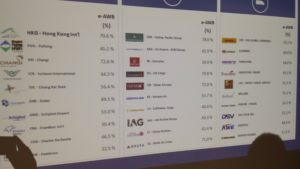The electronic air waybill (e-AWB) penetration rate for October was 44.7 per cent – still some way of the 2016 year-end target of 56 per cent set by the International Air Transport Association (IATA).
Next year’s target penetration rate also looks like a tough one to hit, as IATA’s head of cargo, Glyn Hughes (pictured above) said in Geneva yesterday at the IATA Cargo Media Day, the target for 2017 will be 62 per cent.
In October, the top performing region by e-AWB volumes was the Middle East with 68 per cent, but the likes of Europe, the Americas and Asia Pacific are lagging behind, at 34 per cent, 40 per cent and 45 per cent, respectively.
Hughes explained the three regions are behind due to many air cargo operators having old legacy systems and a lack of technology, while the Middle East is the highest as much newer IT infrastructure and processes.
The airport with the highest penetration rate by volumes in October was Hong Kong International Airport with 70.6 per cent. The top airline was Cathay Pacific with 78 per cent and the top freight forwarder was DHL Global Forwarding with 55.3 per cent.

Hughes said there are obstacles to increasing the e-AWB penetration rate, including regulatory constraints, a lack of harmonisation, a lack of technological compatibility, and complex processes that exist.
E-AWB adoption showed a great surge in its initial introduction but this has slowed, which Hughes puts down to it now reaching a “maturity threshold”, meaning the next noticeable percentage increase becomes much more difficult to achieve.
Hughes said IATA is looking to accelerate e-AWB growth through more e-freight trade lanes, airports SOPs – common standard operational procedures, via its e-AWB Link initiative where SME freight forwarders can send and manage electronic shipments using over 120 carriers, its playbook e-AWB guide and by introducing e-AWB360 into key airports.
IATA’s e-AWB360 campaign has been rolled out to 19 airlines and 21 airports and Hughes said it is a “critical” initiative as it involves various stakeholders at gateways and the association is aiming to run it at 35-40 airports by the end of next year.
Hughes concluded: “Growth has been consistent, but not quite as fast as the industry wants it. There has been lots of challenges and obstacles. It will require quite a bit of effort but I think we have a lot of traction and the airlines and freight forwarders are supportive.”


